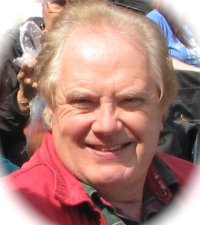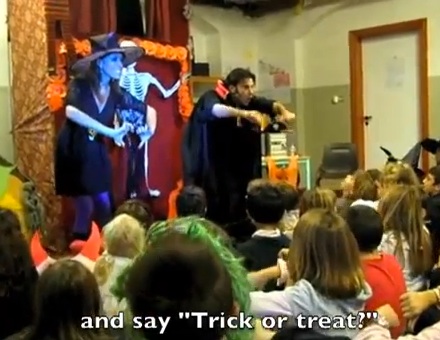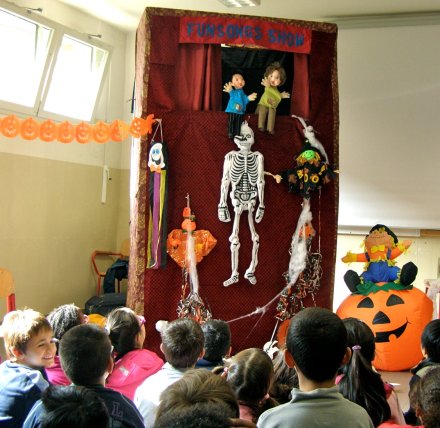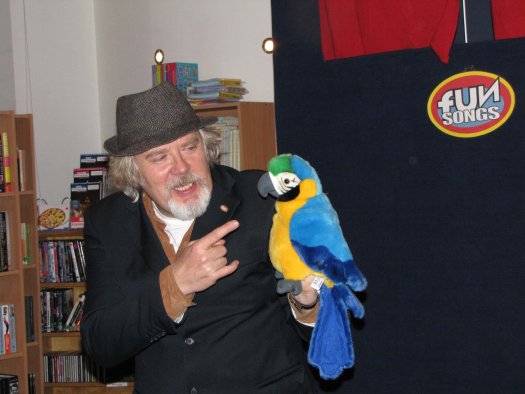Meet Itty and Britty – Introducing the FunSongs Show
Charles Goodger, Bologna University
Charles Goodger is an author, musician and teacher trainer for Pilgrims and Bell International. Charles Goodger speaks six languages and works as an esperto linguistico at Bologna University. He writes educational theatre workshops, action songs and graded worksheets for Windsor-based FunSongs Education.
E-mail:charles.goodger@funsongs.co.uk, goodger.charles@gmail.com

Menu
Introduction
How the FunSongs Show started
How the FunSongs Show accelerates language learning
Transforming the space
Seating the audience
Comedy and pantomime
Itty and Britty
Use of the FunSongs Method in a show
Conclusion
This article tells the story of the FunSongs Show, a balanced mix of comedy, pantomime, bilingual puppetry and action songs geared to enhance second-language learning in children of primary school age. The FunSongs Show is a dynamic example of how the collective learning of new language chunks through music and mime, rhythm and rhyme in a highly entertaining and engaging context, can accelerate language acquisition.

FunSongs actors teaching the action song “On Halloween”)
In 1999 I was living in Bergamo, Italy working as a freelance writer, teacher and musician. I had already started to develop the FunSongs Method of language learning, set up a start-up in the UK and published two courses, FunSongs One and FunSongs Two. These were being distributed to varying degrees of commercial success throughout Italy. One morning in February I received a call from Marzia Luzzini, an English teacher from Saronno, a town north of Milan. She had been asked by the local library to organize a foreign-languages day event for local children and families at the end of March. Marzia had heard about my new action songs and workbooks and called to ask whether I could stage a FunSongs workshop for young learners of English and their parents at the library.
I was already aware performance was a key element in the FunSongs experience – children love to show off - especially in front of their parents. However the idea of an actual event with actors teaching my action songs had not occurred to me. An Italian friend, the writer and dramatist Giuseppe Goisis (now well-known in Italy) suggested the idea of a puppet show. I thought about the difficulty seven and eight-year olds would have in understanding an English-speaking puppet and came up with the idea of Itty and Britty. Once there was a vision and a plan, things began to move. Through friends, I contacted the Argentine puppeteer Chango Gonzalez then living in Milan. For a million lire he made me the very first pair of bilingual puppets Itty and Britty and an impressive portable puppet theatre erected over an aluminium pole structure.
The next few weeks before the Saronno library show were spent writing and rehearsing. I recall that first show at the library based around my song “I Love Summer” with three male actors was far too long. It lasted almost two hours! However the event was appreciated enough for me to realise that this venture was worth pursuing. The ideal format and length - just under an hour - of a FunSongs Show with two actors one male, one female, wasn’t reached until 2003 following many experiments and feedback from teachers and children. The show in its 18 different versions is constantly being updated.
Now at the time of writing, spring 2013, over a thousand FunSongs Shows and events have been staged and performed to at least 100,000 primary-school age children in schools in Italy and Latvia.
Each FunSongs Show gives participants a useful and unforgettable language-learning experience that can be exploited in class. A FunSongs Show experience engages learners musically, emotionally, kinaesthetically and linguistically. It is this blend of different intelligences and learning channels that makes the experience so worthwhile. At different times during the show, children will stand, laugh, speak, sing, mime and dance.
FunSongs shows are performed in the school assembly hall or theatre, a familiar space to the children. Before the participants enter the room hosting the workshop, the actors set up the FunSongs puppet theatre and decorate the space in a way that suggests the theme(s) of the chosen show. As soon as the kids come in and see their usual space transformed, the decorations get minds thinking in a suggestive way about the lexical contents presented in the show’s action songs. For example if the school has ordered a FunSongs Nature Show, the theatre will be adorned with butterflies, caterpillars, plants, symbols representing life, growth and transformation which are the key themes of the FunSongs action song “Nature’s Plan.” We also like to festoon the room with flags from the world’s nations. This underlines the international status of 21st century lingua franca English. The colours of the flags also harmonise well with the theme of most shows’ final song “We are the Future” - written to promote tolerance and respect for different language groups and cultures.
Before the 60 or 70 children taking part in a FunSongs show are allowed into the hall, they are asked to line up outside the doors, boys on the right, girls on the left with the taller children at the end of the line. This is all done in English with the help of one of the FunSongs show actors and becomes a game. The audience are led into the room in pairs of boys and girls and seated on the floor in rows. A line of white tape three paces from the puppet theatre has been laid down to mark the limit of the seating area. We have found that children are more attentive if they are not sitting next to their best friend; at primary school age best friends are almost always of the same sex. For the show to succeed didactically, it is good practise to insist on optimal conditions for concentration, listening and focus. As the children come in and sit down to await the start of the show, the other FunSongs actor is hiding behind the puppet theatre ready for the show to start. He will then be introduced and make his appearance as the comic pronunciation teacher, Professor Krettins.
Laughter is a great way of anchoring the children’s attention. Most FunSongs Shows start with an interactive pantomime-like sketch guaranteed to provoke unfettered mirth. One of the actors emerges from behind the puppet theatre dressed as Professor Krettins from Oxford University who “has come all the way from England” to take part in the show. Professor Krettins is a strict and unsmiling phonics expert. He wears heavy black-rimmed glasses and baggy pants. As he drills some key chunks from the show’s final song “We are the Future,” he gets angrier and angrier with the kids. This is because a toy parrot (handled by the other actor in the puppet theatre) keeps popping up behind him and disappearing. As soon as the kids see the parrot they point. Professor Krettins thinks the children are mocking him. Of course the angrier he gets, the funnier the situation becomes.
Over the years we have developed a number of dynamic gags based on double-entendre and situations first presented by the bilingual puppets. Provided the actors get the timing and stage blocking right, these comic interludes always provoke laughter.
Watch part of the Professor Krettins sketch on the FunSongs YouTube channel.
FunSongs Shows feature two funny and attention–catching puppets. In Italy, the puppets are called Britty and Itty. Britty speaks English with a slow ponderous delivery while Itty speaks fast Italian. In Latvia, the other country in which FunSongs shows have been performed, the puppets are named Britty and Latvian-speaking Latjjs. The scripts are designed to present, in bilingual dialogue form, the key themes, words and language chunks of the action song the children are taught immediately after hearing the puppet sketch.
What Britty says is echoed and translated for the children to understand. The sound of the English hangs in the air while it is rapidly translated into the children’s L1. To give you an idea of how this works, here is how the puppets introduce themselves at the start of a show:

The bilingual puppets Itty and Britty entertain and instruct their audience
(Britty speaks with an emphatic music-hall compere style. Itty, fast patter)
Britty: Ladies and Gentlemen, Boys and Girls
Itty: Signore e signori, ragazze e ragazzi
Britty: Welcome to our show, the FunSongs Monster Show
Itty: Benvenuti al nostro spettacolo. Il FunSongs Monster Show
Britty: My name’s Britty, and I’m English
Itty: Lui si chiama Britty e lui è inglese. Io invece sono Itty e sono italiano!
Britty: Listen kids! We’ve got two friends who speak English, to help you learn our action songs
Itty: Abbiamo due amici che parlano inglese che vi insegneranno le nostre canzoni animate.
Extract from the introductory FunSongs Show Itty and Britty puppet sketch
© Charles Goodger, FunSongs Education
Provided they are manipulated well, puppets will grab the children’s attention. For example in the puppet sketch designed to introduce the action song “The Monster March”, a funny Dr Britty “treats” his sick patient Itty with a hammer for testing reflexes before being summoned away by the police. The script provides a context in which to highlight parts of the body, which will then be taught and sung in the action song “The Monster March”.
FunSongs show actors are experts in the use of the FunSongs Method in which an action song acts as a presentation vehicle for teaching new language. In a show, the action-song teaching process is always conducted in the same way.
First the themes and main vocabulary items in the target song are presented in a bilingual puppet sketch.
After the sketch, the music starts up and the two actors step out from behind the puppet theatre to present the song and its actions.
Next everyone participates in the collective learning of the action song through drilling and repetition. One of the actors enunciates the lines of the song in spoken form; he illustrates the meaning of each language chunk through a graphic gesture. The other actor helps the audience to repeat both the chunk and the gesture.
After drilling two or three chunks, the lead actor returns to the first chunk and sings it, accompanying the English with the appropriate graphic action(s) in a three-steps-forward, two-steps-back system until the whole song has been taught. In this way - and in the space of a few minutes – the song starts to plant itself in the learners’ long-term memories.
Finally the backing music is put on and everyone stands up for a celebratory performance of the song. After the show in the classroom, the teacher should complete the action-song learning process. She can integrate the lexical and linguistic content of the show’s song into her course by recycling the language through the graded worksheets downloaded from the FunSongs Education website.
There are many different FunSongs shows; indeed most FunSongs action songs have a show built around them with a dedicated puppet sketch. FunSongs shows will appeal to primary school children whatever their age and ability as children can relate to what is going on different levels. So how should a teacher decide which FunSongs show(s) to order for her classes? Well from a didactic perspective the best policy is to choose a show that anticipates a specific theme in the curriculum. For example if you know you will need to teach your class parts of the body by the end of March, a good choice could be the FunSongs Monster show. In this way your students will learn “The Monster March” which contains 14 parts of the body in the space of an unforgettable two-minute action song. If you are working with very young learners experiencing English for the first time you might like to order the “What’s Your Favourite Animal show” in which children learn a simple action song about the sounds animals make.
For older children teachers often pick shows that highlight broader themes such as medieval history (“FunSongs Robin Hood show”) or ecological issues (“FunSongs Water show”, FunSongs World show). My advice is to choose a show that best exploits the didactic value of the experience in a way that brings your children closer to the language you need to teach.

Charles Goodger as Professor Krettins
In this fast-moving 21st century more and more school-children have access to smart-phone games and sensory digital distractions. Kids easily get bored which of course means teachers have to work harder than ever to induce interest and focus. One of the most effective ways of motivating children is to entertain them, awe them and engage them on an emotional and expressive level.
The FunSongs show and FunSongs Method set out to do this.
Teachers and schools directly interested in booking or performing FunSongs shows or in acquiring a FunSongs Show franchise, are kindly asked to contact me.

Please check the Methodology and Language for Kindergarten Teachers course at Pilgrims website.
Please check the Methodology and Language for Primary Teachers course at Pilgrims website.


|